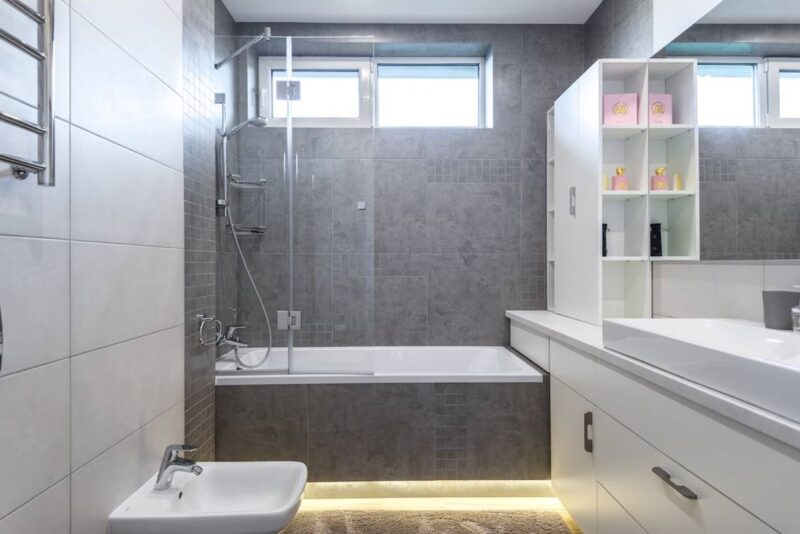Compact bathrooms present unique challenges when it comes to functionality and aesthetics. According to a survey by the National Association of Home Builders, the average bathroom size in the US is only about 36 – 40 square feet. This leaves little room for large fixtures or large storage solutions. Additionally, data shows that urban bathroom sizes tend to be smaller, often less than 40 square feet. With such confined spaces, compact toilets and other space-saving fixtures become essential.
Small bathrooms can be as inviting and useful as larger ones by getting creative with layouts, storage, and multi-functional fixtures. You must identify your priorities and needs and then maximize every inch. With smart planning and strategic design choices, you can create a bathroom that’s functional and also looks beautiful.
Rethink Traditional Layouts
The standard tub-toilet-sink layout found in most bathrooms is not always the best use of space in a small bathroom. Flipping the layout so the toilet is across from the tub rather than beside it can open up ample floor space. Exploring a wet room style by removing walls and barriers between spaces can also make a small bathroom feel more expansive.
Consider mounting the sink on a side wall rather than centering it on the back wall to create better traffic flow. Floating vanities with thin legs are another way to maintain openness and flexibility in floor plan options. Analyze the existing plumbing and electrical setup to determine feasible layouts before committing to a final plan.
Consider Walk-In Tubs
If you want to remodel your bathroom for better accessibility, walk-in tubs are a great space-saving option. You can consider hiring one of the walk-in tub specialists such as the EZ Baths & Walk-In Tubs, who can offer the most optimum solutions to fit small spaces. The low threshold allows easy access without compromising style or taking up additional space. Focusing the layout around a walk-in tub can help maximize a small footprint.
Look for walk-in tubs with built-in seating and hydrotherapy water jets for a spa-like experience. Sliding or outward-opening doors facilitate entry better than inward-swinging doors in a cramped bathroom. Just ensure the necessary drain configuration based on the tub location.
Embrace Multi-Functional Fixtures
Multi-functional fixtures that combine storage with necessities like sinks and showers are perfect for small bathrooms. Corner sinks maximize the use of converging walls, while built-in shelves under floating shower heads add space for toiletries. Sinks with integrated legs or cabinets increase storage while maintaining a small footprint.
If remodeling, look for tub and shower combos. Sliding barn doors on tub/shower combos can fully enclose or open up the space as needed. The key is choosing fixtures that serve multiple purposes without consuming extra square footage.
Take Advantage of Hidden Storage
While large vanities are unrealistic in a small bathroom, storage can still be optimized through discrete built-in spaces. Niches carved into walls are great for stashing toilet paper rolls and cleaning supplies. Install extra shelving inside frames behind removable panels.
Moreover, cabinets with mirrors maximize functionality and create an illusion of depth.
Look for bathroom fixtures like sinks and vanities with drawers built into the base. Use the area behind pipes for narrow shelving. The tank top and side of the toilet are also prime areas for storage. Get creative with recessed nooks in the wall for toiletries and linens.
Consider Compact Toilets
Standard toilets need at least 30 inches of clear floor space in front. Compact models with smaller footprints can shave off several inches while offering full functionality. Choose a wall-mounted toilet that eliminates the base for even more space savings. Just install reinforced framing behind the wall for proper support and stability. Carefully weigh the pros and cons of each type of compact toilet option.
Install Space-Saving Fixtures
From shallow rectangular vessel sinks to corner-mount faucets, compact fixtures let you maximize every inch without sacrificing style. Floating vanities with thin legs have a lighter visual impact than bulky cabinets. For showers, neo-angle enclosures eliminate wasted corner space.
Rainfall shower heads positioned high on the wall also help create an illusion of height in a small bathroom. The smaller the fixtures, the more flexibility you’ll have with layout options. Just ensure good reinforcement behind walls.
Strategically Use Glass and Mirrors
Visually enlarging a small bathroom is key to making it feel more expansive. Full-length mirrored doors on shower stalls or soaking tubs reflect light and create an illusion of depth. Mirrored cabinets also add functionality. Avoid dark or opaque glass enclosures that can make rooms feel closed in.
Strategically placed mirrors that reflect windows or other light sources can make a bathroom feel brighter and more open. Keep in mind mirror placement to avoid blind spots that hinder visibility. Frosted glass on shower doors or windows lets in light while obscuring views and maintaining privacy.
Work With Available Natural Light
Proper lighting prevents a small bathroom from feeling dark and cramped. Take full advantage of existing windows by opting for light, minimal window treatments. Complement with ample LED task lighting at the vanity and shower, as traditional overhead lighting, can cast shadows in a confined space.
Solar tubes or skylights can funnel sunlight through the roof if no natural light is available. Install dimmers to adjust lighting according to your mood. Proper illumination is key to making a small bathroom feel open and inviting.
Stick With Light, Neutral Colors
Dark colors make small rooms feel closed and even smaller. Stick to light, neutral hues like soft whites, greys, and pale blue-greens to keep things bright and airy. Monochromatic color schemes with varying shades and textures of one color can also create an illusion of expanded space.
If you want to incorporate an accent wall, limit vivid colors to one wall and stick to muted shades. Consider painting the ceiling a lighter tone than the walls to create height. Contrasting colors in geometric designs can make rooms appear larger, but avoid busy patterns in tiny spaces.
Conclusion
While small bathrooms undoubtedly pose challenges, they provide the perfect opportunity to get creative with layouts and multi-functional fixtures. Focusing on light colors, glass elements, hidden storage, and space-saving sinks and toilets allows you to maximize every inch. With strategic planning and a few smart design tricks, even the tiniest bathroom can be transformed into a beautiful oasis. The key is using compact fixtures and visual tricks to make a small space feel open and inviting.









